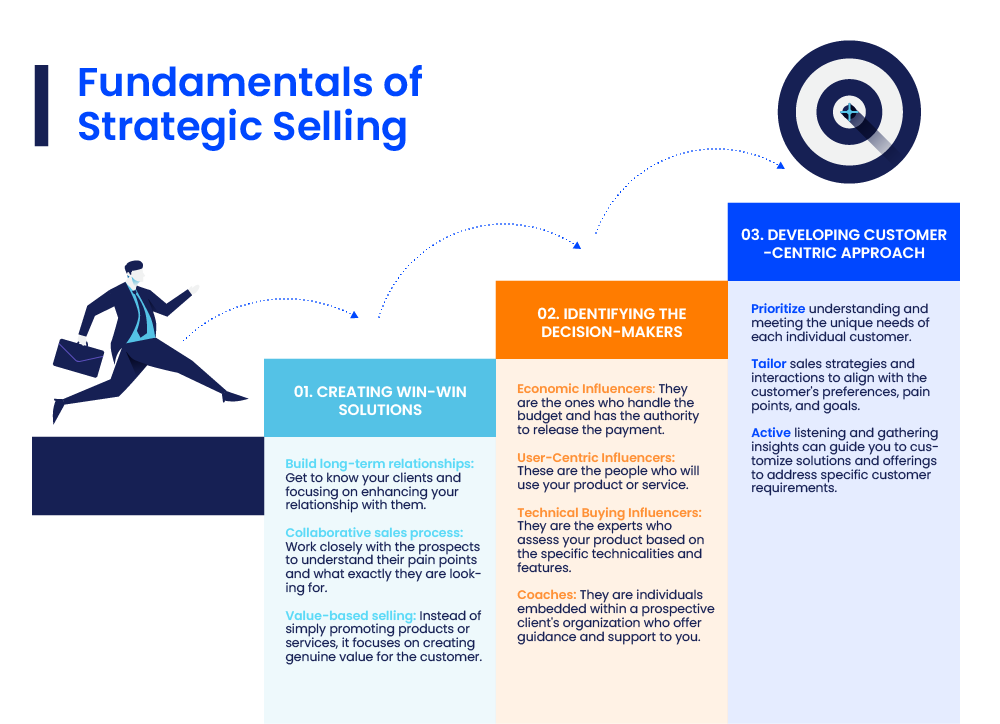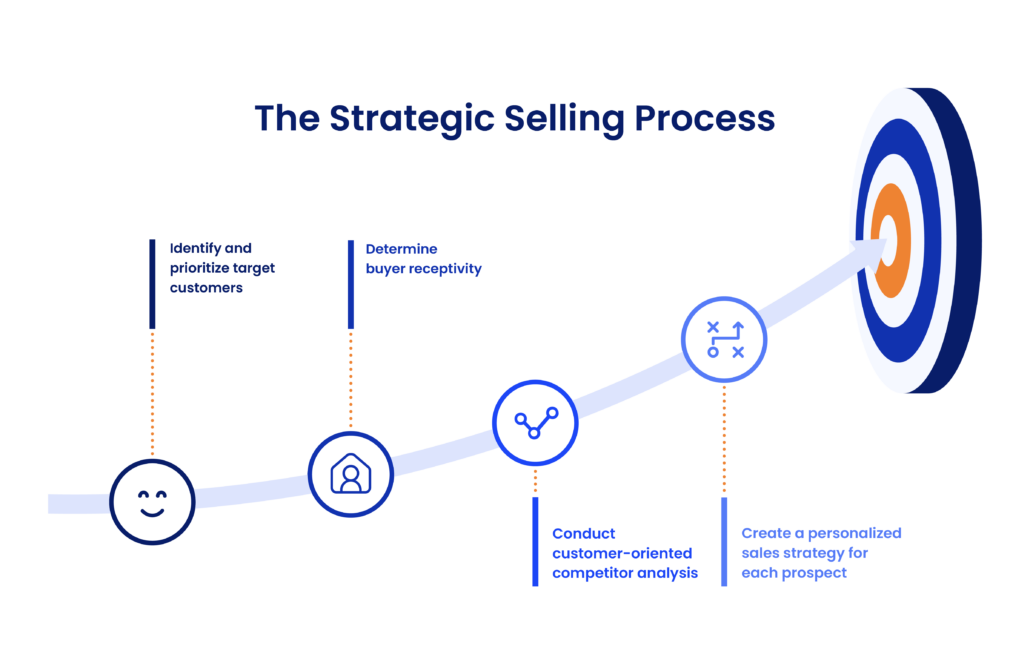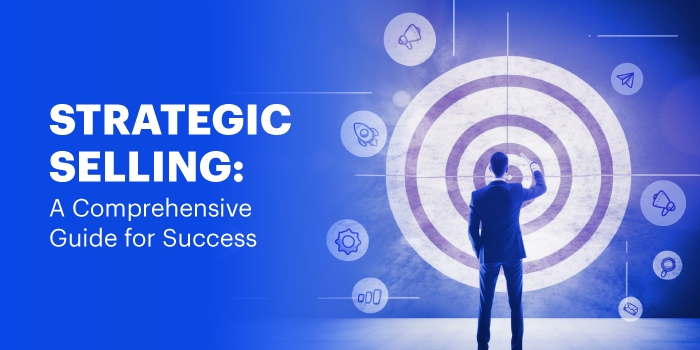It’s often said that, “if you’re trying to sell to everyone, you’ll end up selling to no one.”
Conducting sales without a clear direction is simply ineffective. Each potential customer comes with unique needs, budgets, and decision-makers in the mix. That’s why a well-defined sales strategy is essential – it enables you to precisely target and cater to these individual requirements.
How, you ask?
Strategic selling is the answer! It’s a sales strategy that takes a customer-centric approach to selling and focuses on creating a mutually beneficial relationship between the buyer and the seller.
Before we go into how you can effectively use this strategy to increase your conversions, let’s first understand what it is exactly.
What is Strategic Selling?
Strategic selling is a concept that provides a framework for sales professionals to sell with a buyer-focused approach.
It focuses on creating long-term, mutually beneficial relations with your customers. It breaks down complex sales processes into actionable steps.
Unlike traditional selling, it does not focus on the product and its features. It gives emphasis to the value it provides to the consumer.
This strategy is mainly applicable in B2B organizations where there are multiple decision-makers. Each of them has separate issues dealt differently. Strategic selling helps tailor the product that gives a solution to all these problems.
Let’s understand the key characteristics of strategic selling and how they aid in solving the problems.
Fundamentals of Strategic Selling
Let’s go through some features that make the core of strategic selling:

1. Creating Win-Win Solutions
- Long-term relationship -You are not there to pressure them into buying your product and earn a sale. Getting to know your clients and focusing on enhancing your relationship with them is the key.
Here you are not only looking at the immediate sale but also at future cross-selling opportunities.
- Collaborative sales process – Work closely with the prospects to understand their pain points and what exactly they are looking for. It is vital to tweak your strategy according to what stage of sales funnel they are in. This will help you save time and offer customized solutions.
- Value-based selling– It is an approach that requires you to understand and meet the specific needs of clients. Instead of simply promoting products or services, it focuses on creating genuine value for the customer.
This involves thorough research and active listening to grasp the client’s pain points and goals.
With this knowledge, customize your solutions to directly address these needs, whether through product features, pricing adjustments, or additional services.
Importantly, emphasize the long-term benefits they will gain, such as increased efficiency or cost savings.
This benefits both the customer, who receives tailored solutions, and the business, which cultivates a loyal customer base for sustained growth.
2. Identifying the Decision-makers
According to the strategic selling methodology there are four main types of influences impacting the sales decisions:
- Economic Influencers – They are the ones who handle the budget and has the authority to release the payment.
It could be an individual or a group of people. They might not necessarily use the product themselves but are responsible for the financial aspect of the purchase.
What economic influencers care most about is the return on investment (ROI) and does the product/service fit their budget.
The way to sell to them is to emphasize how your product can boost their revenue and is a valuable investment.
- User-Centric Influencers– These are the people who will use your product or service.
They’re mainly focused on things at a basic level, like how easy it is to use, how safe it is, and how to put it into action. Here you focus on how your product is user-friendly, how it will reduce their workload and make their life easier.
For example, if you are selling a CRM, you can emphasize on how automation can help them close more deals.
- Technical Buying Influencers– They are the experts who assess your product based on the specific technicalities and features.
They look into whether your product matches the specifications that their organization needs. They then evaluate the measurable and quantifiable parts of your product.
Here, you need to highlight how your product smoothly integrates with their current ecosystem, how easy is the implementation, etc.
- Coaches– They are individuals embedded within a prospective client’s organization who offer guidance and support to you.
They help you with insights like the practical usage of your products or services for the prospect’s organization to help you tailor your pitch. They might also advocate for your product, assist you in navigating internal processes, offer insights into the competitive landscape etc.
Building trust, asking pertinent questions, and leveraging their influence is essential to close deals successfully.
3. Developing Customer-Centric Approach
Strategic selling prioritizes understanding and meeting the unique needs of each individual customer. It involves tailoring sales strategies and interactions to align with the customer’s preferences, pain points, and goals.
Active listening and gathering insights can guide you to customize solutions and offerings to address specific customer requirements.
Furthermore, it involves providing exceptional post-sale support and maintaining ongoing communication to ensure complete customer satisfaction and loyalty.
This not only leads to higher customer retention but also increases the likelihood of referrals, positive word-of-mouth, and upselling opportunities.
Now that you know the characteristics that make up the strategic selling methodology, let’s understand how to implement it.
The Strategic Selling Process
Here’s the four-step process you can follow to start your strategic selling journey:

1. Identifying and prioritizing target customers
- Since strategic selling is a long-term process, it is crucial to spend time on prospects that fit your ideal customer profile. These profiles are created by taking into account the demographic, geographic and psychographic details of the customer. You can create your own customer profiles using this free checklist and template.
- Conducting thorough prospect research– Once you know about your ideal customer profile, you need to research and learn about various buying influences that play a role in winning sales. You can use websites like LinkedIn or networking events to learn more about these influences. Your coach can also help you identify and meet with key decision-makers.
- Understanding degree of influence– Identification is not the only thing that needs to be done. Although there are multiple stakeholders, the amount of influence they have is
Therefore, you need to determine the degree of influence they hold. Asses what domain they are from and if that is relevant to your product/service. You can then prioritize the people who have a greater influence on the sale of your product.
2. Determining buyer receptivity
The way you present your pitch would differ based on how buyers perceive their business situation. It is important to know when to approach the buyer according to their business needs.
According to strategic selling, there are four different response modes based on how buyers evaluate their business situation. For each of these responses, your sales approach should be different. The four response modes are as follows:
- Growth: The buyer is essentially aware of the problem. They know there is a gap between the desired results and the reality. They are ready to take that leap and see growth. This is the easiest response mode to sell to since they are receptive to change.
- Trouble: The buyer has an issue, and they want a solution that can take things back to normal. But there is a difference between growth and trouble response. In growth response, the buyer wants to improve an already good situation. On the other hand, a buyer in trouble mode wants a solution that can quickly resolve their issue. The sales proposal presented must be such that it gives the fastest solution for the problem.
- Indifference: Here the buyer does not see a gap between what they desire and the reality. It Is difficult to sell in this situation. The only thing that might make them want to buy is when they see growth or trouble coming. You can show them the results they have settled for is far less than what they can possibly achieve with your product or service.
- Overconfidence: This is when the buyer’s perceived reality is way better than the actual reality. They are the most difficult to sell to. Either they are ignorant of their reality or have goals set so low that their poor performance is perceived to be good. It is wise to eliminate this prospect from being a potential buyer.
3. Customer-oriented competitor analysis
When we talk about competition in strategic selling, it has many factors other than your actual competitor companies. To capture the full picture of your competition, you need to include the other competitions like:
- Companies might come up with their own internal solution
- They might allocate the budget for some other purpose
- They might decide your product is not worth it
You might be wondering how to analyze competition with a focus on your potential customer. Here’s how:
- Determine the competition- Identify all the alternatives mentioned above. Explore whether your prospect has any potential internal solution. Find out whether the customer is facing other issues that might take away your budget. Scope out other companies that are also looking to solve the same problem as you.
- Examine your competitor firm’s strategy- Here you assess the firms that are competing with you for the same business. Compare the price difference, features and offerings of their product with yours.
- Figure out what makes you unique- This is the most important part. What is your unique selling proposition (USP)? Make a list of contributions that your product is making to their company. You should have at least one such contribution that makes you stand out and is important for their organisation.
4. Creating a personalised sales strategy for each prospect
Now that you have all the necessary details for your strategy, it’s time to create it.
You should create a strategy that showcases a measurable impact to the prospect’s organization. Not only that, but it also needs to be personal.
The way strategic selling puts it is, Win-results. You need to identify what are considered wins for the buying influences and incorporate them.
Draft an action plan that has doable and logical actions that you can perform
The following are things that you must include in your actionable sales strategy–
- Define who will be the part of the sales meetings. Ensure it’s the person best qualified for it.
For example, for a meeting with an economic influencer, you might want to arrange a person from the executive level to see them. - Mark down the response modes that each buying influencer is in. Make your action plan accordingly. It is important to focus on influences who are in growth or trouble mode first.
- It is important to note that getting a win result for every influence might not be possible. But is essential to keep track of what is considered a win for all of them including yourself.
- Include the value addition you bring to the customer. Think about not only the product but also other things like customer service, support, customizations etc.
- Finally, after every sales call, re-asses and re-consider everything with the new information
sand adjust your sales strategy accordingly.
Now that you know how to implement the strategic selling process, let’s look at ways you can leverage technology to make it easier for you.
Strategic Selling in Changing Market Dynamics
Strategic selling is a long term ever-evolving process. With the fast-changing business world, technology like customer relationship management software (CRM) can be your best friend. A CRM like Leadsquared can be a backbone to your selling process in the following ways:
1. Utilizing data to drive sales decisions
You can use a CRM in many steps during strategic selling. While you are creating an ideal customer profile, you can use the CRM for customer profiling. You can track your prospect’s journey to understand what stage of buyer’s journey they are on.
You can also capture information on buying influencers and understand where they are in the lead funnel.
Based on the data, you can collaborate with your marketing team to run account-based marketing campaigns.
2. Leveraging technology for sales insights and analytics
A CRM is a centralized platform for all your sales activities. You can keep a record of sales calls, and demo meetings with different stakeholders.
Create notes on all the meetings to get useful insights for your next sales call.
Through features like smart views on LeadSquared, you can have a view of your prospects and all your tasks and reminders all at one place.
You can also easily update your action plan and create updated strategies then and there.
3. Using data to anticipate customer needs and preferences
Once you have made the sale, there are other after-sales services that are crucial.
You can schedule automated emails and set reminders to check-in on your customers and build long-term relationship. Another great way a CRM can be helpful is by identifying opportunities.
CRMs like LeadSquared have features like opportunity management. Through this you can identify the up-sell and cross-sell opportunities for your products. This can be done by keeping track of your stakeholders’ activities. You can jump on these opportunities and win more deals with the existing customers.
Final Thoughts
Strategic selling is a long sales process and requires a lot of time and energy. But it is a fruitful methodology that yields results, beneficial for both you and your customer.
This in turn, creates a long-term relationship with your customers for future projects too. You can also use technology like Customer Relationship Management (CRM) to help improve customer relations, by making your selling process more streamlined.
FAQs
1. What are the advantages of strategic selling?
Strategic selling offers numerous advantages, including stronger customer relationships, greater customer retention, enhanced cross-selling and upselling opportunities and long-term sustainable growth.
2. Why is strategic selling also called the Miller Hiemen Sales Methodology?
Strategic selling as a concept was first introduced in 1985 by Robert B. Miller and Stephen E. Heiman in their book ‘The New Strategic Selling.’
3. What are the disadvantages of strategic selling?
Although it has numerous advantages, strategic selling can be time and resource intensive. It is also complex and requires a deep understanding of the market, competition, and the customer’s specific needs. Having a CRM like Leadsquared can help you tackle these challenges effectively.









